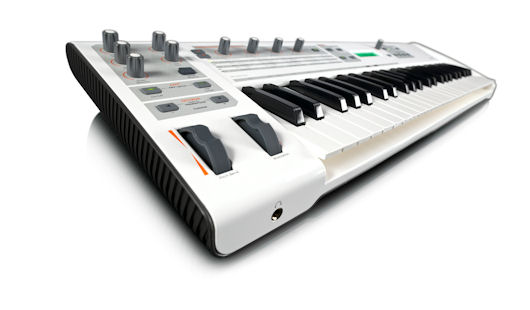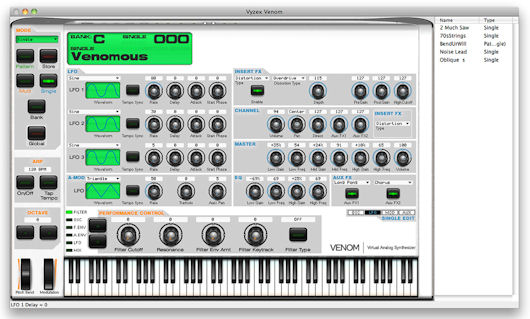M Audio Venom review

In the current musical climate, the terms ‘analogue modeling’ and ‘virtual analogue’ are commonplace within the synthesizer communities. Indeed the new generation of producers largely expect their hardware to have the same features and reliability when it comes to presets, saving, MIDI and effects capabilities as the software VST instruments on the market.
Virtual analogue – or VA – is essentially the process whereby a synthesizer simulates the analogue sound through its internal DSP components (as opposed to generating the tones from analogue circuitry). Classic examples of VA beasts have included the Nord Modular and the Access Virus, with M Audio now stepping into the frame with their all new 12 voice polyphonic Venom. This contemporary looking 49 key slab represents all that is good about analogue synthesis, incorporating 512 individual sound patches, 256 layered patches (both split between factory and user banks), the highly detailed Veyzex sound sculpture and editing software plus an integrated 2 x 24 bit 44.1 kHz USB MIDI interface.
“The factory presets have been skillfully designed and range from ribcage shaking basses, organic organs, pads and swirls which can vary from sharp and clean through to murky, complex atmospherics”
The build is very good, featuring a high density plastic casing with smooth curves and sturdy, full size keys. The rubberized pitch-bend and modulation wheels have a pleasing action, with the only slight concern being the slightly wobbly knobs (however even after a decent amount of abuse they remained intact and functional). Connection possibilities include a brace of 1/4” TRS jacks, with the stereo aux input over phono jacks and instrument insert, microphone, expression and sustain pedal inputs again over 1/4” TRS. 5 PIN DIN MIDI in/outs, a USB port, 9v DC input (this unit is too big to be bus powered) and a headphone socket. The user interface is not over complicated, featuring global controls to the far right consisting of master volume, synth volume, direct monitor, mic gain and instrument gain with a mono monitor switch. Below this you’ve got the ARP on/off, latch and tap tempo split between two green back-lit rubber buttons and even further down, above the aforementioned pitch-bend and mod wheels, the octave up/down keys.

Horizontally along the top there’s the performance control module, a 6 x 5 column matrix with four knobs which can be assigned to almost everything needed for a knob twiddling work out, filtering (resonant multi mode with tube saturation limiting and 6 variants from 12 dB/octave (2-pole) low pass through to 24db/octave (4-pole) high pass with cutoff, resonance envelope amount and keytrack) three LFO’s and three AHDSR plus effects. Moving right there are the four mode switches comprising Pattern (for editing arpeggiator patterns), Multi (which switches to one of the 256 banks of combined sounds), Single (offering access to individual sounds including 512 preset patches) and Store. Further to the right there’s a 9 x 2 mm green backlit LCD screen, step value encoder and bank select key before you arrive at the Multi Control module which enables you to select any of the four parts of a Multi Program for editing.
“What you get out of this synth is completely up to you – it is ready to use out of the box but you could easily spend a lifetime programming it to perfection”
These controls are all well and good for standalone performance mode, but the real potential of the Venom is only truly unlocked when the Vyzex Venom software is installed. Included in the package, it gives the user a much more detailed visual display of each the synths key attributes with two different operating modes; Direct Bank gives you complete control of Venom’s banks, synchronizing what you do onscreen seamlessly with the internal guts of the instrument. Virtual Bank mode lets you work “offline” within the software’s own banks, sending to the Venom’s memory as required. This is a particularly useful feature if planning a complicated performance, as it lets you create different memory templates for individual moods or songs. The analogue styled interface within Vyzex is very impressive and really pushes the sculpting capabilities. There are 41 different waveforms to shape and 53 drum sounds, three oscillators and LFOs worth, which can be layered to make up one of the 12 simultaneous voices and split across the keyboard. Insert effects – which consist of compression, EQ, Distortion, Bit Reduction and Decimatior – can also be added. Layering sounds in this manner gives a truly individual results which can then go on to re-name and latch to the arpeggiator or insert into multi mode with your other creations.
Once you’ve mastered the workflow it’s unlikely you’ll be spending too much time trawling through the factory presets – as impressive as they are – although at this point it’s probably a good idea to talk about the overall sound characteristics of the Venom. The first thing you’ll notice is that it’s big and powerful – the raw waveforms sound as pure as a Moog, although maybe lacking a bit of that vintage warmth. The factory presets have been skillfully designed and range from ribcage shaking basses, organic organs, pads and swirls which can vary from sharp and clean through to murky, complex atmospherics. What you get out of this synth is completely up to you – it is ready to use out of the box but you could easily spend a lifetime programming it to perfection. The global effects are decent too; with two busses of Reverb, Delay, Chorus, Flanger and Phaser which have all the parameters you’d expect for fine tuning. Combine this with the super-fat filters and you have a comprehensive workstation synthesizer at a solid price. [More info at Juno]
Specifications:
| Voices | 12-voice polyphony |
| Oscillators | 3 |
| Waveforms | 41 |
| Drum Sounds | 53 |
| Presets | 512 onboard Single patches, 256 onboard Multi (layered) patches |
| Global Bus Effects | 2 feat Reverb, Delay, Chorus, Flanger, Phaser |
| Insert Effects | Compression, EQ, Distortion, Bit Reduction, Decimation |
| Arpeggiator | classic arpeggiator with up, down, and alternating patterns |
| Soundcard Features: | built-in USB 2.0 audio/MIDI interface (USB 1.1 backward compatible) |
| 2 x 2 24-bit, 44.1 kHz operation | |
| mic, instrument, and stereo line level inputs route to DAW | |
| synth sounds route to DAW | |
| DAW audio output mixes into main outputs | |
| stereo main audio outputs (1/4″ TS) | |
| stereo headphone output (1/4″ TRS) | |
| master volume knob; instrument and mic gain knobs | |
| MIDI In and MIDI Out (5-pin DIN) | |
| Other | sustain (1/4″ TS) and expression (1/4″ TRS) pedal inputs |
| Vyzex Venom software editor: | arrange sounds into banks, rename patches, and save backups |
| patch collider feature mashes up multiple patches to create new hybrid sounds | |
| 16-cell modulation matrix offers comprehensive routing configurations | |
| Keyboard | 49-key, full-size, synth-action keyboard |
| System Requirements | PC: Windows XP 32-bit (SP3)*, Windows Vista 32/64 (SP2), or Windows 7 32/64 |
| 1.8 GHz multi-core processor | |
| Mac: OS X 10.5.8 or 10.6.2 | |
| 1.8 GHz multi-core processor |